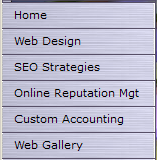We have now captured the attention of our viewer by telling them clearly the benefits of what we offer. They like what they see and they want more. How you present that "more" is very important to keeping your visitor around long enough to respond to your Call to Action (more on Call to Action in a later lesson). Think of a website navigation scheme as a pyramid where the information offered is more specific and succinct at the top of the pyramid and becomes broader and deeper as you delve further into the website. The information is more complete and offers a greater explanation of the topic pursued as you go further down the pyramid and deeper in the navigation. This allows the visitor to decide how much they want to pursue, rather than having to slog through too much or more information than they want too soon. Most newspaper articles and press releases are written like this.
Where should the navigation be placed? Generally speaking, navigation placed either at the top of the page or on the left side of the page will receive more of the reader's attention. There are heat maps that show that these locations are where a viewer's eyes travel first. My preference is to have two navigation areas with one being smaller and oriented to typical expectations such as HOME, CONTACT and SITEMAP. Then the second navigation area can include ABOUT, PRODUCTS, SERVICES, ARTICLES, NEWS, etc. No matter what you decide, always, always keep the nav areas consistent from page to page. If a viewer has to hunt for navigation in different locations for each page, they just won't. They will go to another site where it's easy to get around. Bottom page navigation on the first page is not a bad idea either. I often use javascript for my navigation menus so that changing the nav bar on 25 pages only requires a change to the menu.js file and all pages running this script display the new menu. However, the downside to this technique is that Google and other search engines won't necessarily index the contents of the javascript file and, therefore, the website won't have all of its pages indexed by the search engine. To manage this problem, put an HTML menu of all the website pages you want indexed at the bottom of the home page. Voila! Problem solved. Now all pages are indexed from the home page and will be found by the search engines.
Navigation areas have gone through a lot of changes over the years from buttons to image rollovers to most navigation tends to be text-based. This is also my preference because it is so controllable, easy to modify and readily understood by the viewer. Remember that the purpose of the navigation area is to draw your viewer as deep as they want to delve into your site. Your job is to capture their interest on the home page because success there will attract them to your Call to Action and draw them deeper into your website.
Your homework this week: review your navigation scheme. Are all pages accessible to your viewer? Have you avoided the frustration of the visitor getting lost with poor navigation? Again, have someone (ideally a target prospect) look at your website and let them navigate through the site and listen to their feedback.
Copyright 2012 (c) Tao Consultants Inc. All Rights Reserved.
Reprinted with Permission.


